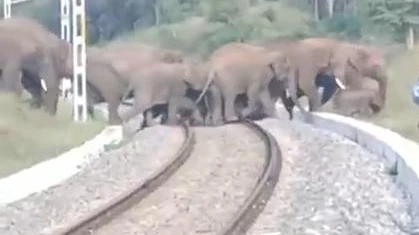Indian Elephants have not been a concern in India, but imported cheetahs are. In December 2022, the Union Environment Ministry informed the Lok Sabha that India had lost 494 elephants to train accidents, electrocution, poaching, and poisoning over the preceding five years. The forest service has not prioritised elephant corridors so far, and due to a lack of interest by the state or the federal government, such initiatives were lacking. The good news is, in Jharkhand, 17 elephant corridors have been identified for the first time out of 150 in the country.
The Indian Wildlife Institute recently submitted the Elephant Corridors of India 2023 report to the central government after evaluating elephant activity across India. The identified corridor inventory has been provided to the states. Now, it is possible to render these corridors inviolable. There have been seventeen elephant corridors in Jharkhand and other states. Now, fragmented regions, such as Galiyara in Jharkhand, will be marked to guarantee their uninterrupted operation. So that elephant herds do not deviate from their paths, the corridor will be maintained free of non-forest land and private land obstructions, and sufficient food resources for elephants will be made available.

- Bhagabilla-Ratnasari Corridor: From Hatgamharia Range in Chaibasa Forest Division to Rairangpur Jungle in Odisha. It is 19 km long and 2-7 km wide. A herd of 26 elephants is expected to arrive from October to February.
- Jampani-Bhagabilla Corridor: From Noamundi Range in Chaibasa to Keonjhar Forest Division in Odisha, passing through Hatgamharia Range in Chaibasa. This corridor is 120 km long and 2-5 km wide. An arrival of 25 elephants is expected from October to February.
- Sialjora-Dhobadobin Corridor: From Saailjora in Chaibasa Forest Division in Jharkhand to Dhobadobin Forest in Rairangpur Forest Division in Odisha. It is 50 km long and 2-6 km wide. The arrival of 33 elephants is expected from October to February.
- Sanga Jata-Haldipokhar Corridor: From Sarai Kela in Chaibasa to Haldipokhar Range in Odisha. This corridor is 96 km long and 2-6 km wide. From October to February, a route for a herd of 74 elephants.
- Lepang-Dumuria Corridor: Elephants use this corridor from Lepang in Noamundi Range in Chaibasa to Keonjhar in Odisha. It is 33 km long and 2-7 km wide. The arrival of 26 elephants is expected from October to February.
- Ankua-Ambia Corridor: Connects Ambia-Saranda Forest to the Mendinburi Reserve Forest in Kolhan Range near Kolhan. It is 8 km long, and from August to March, it is used by a herd of 18 elephants.
- Raiberia-Pulbaburu Corridor: Connects Raiberia in Kolhan to Pulbaburu, Deraowan, Anandapur, and Ambia. It is 8.5 km long, and from August to March, it is used by four elephants.
- Dalapani-Sukalara Corridor: Connects Dalama Abhyaranya to Jamshedpur’s Dalapani and Kankarajor Reserve Forest in West Bengal. It is 2.10 km long and used by 28 elephants.
- Dalama-Chandil Corridor: Connects Chandil, Dalama, and the Western Range of Saraikela Wildlife Sanctuary. It is 5 km long, and the arrival of 4 to 5 elephant herds has increased.
- Dalapani-Kakarajor Interstate Corridor: Connects Jamshedpur’s Dalapani Reserve Forest to Kakarajor and Midnapore in West Bengal. It is 25 km long and 2.5 km wide, used by 45 elephants.
- Dumaria-Nayagram Corridor: Connects Dumaria Reserve Forest in Musabani Range to Nayagram Reserve Forest in Chaikulia Range, near Jamshedpur. It is 6.5 km long and 1 km wide, used by 70 to 80 elephants.
- Silly-Anagda Corridor: Connects Mahiloung Sekhuntee Forest Division in Ranchi East Forest Range to Tamad Range in Tamar Forest Division. It is 25 km long and less than 1 km wide, used by a herd of 24 elephants.
- Bharno-Bero-Kara Corridor: Connects Konekti to Tamad in Mahiloung Sekhuntee Forest Division in Ranchi East Forest Range. It is 35 km long and less than 1.5 km wide, used by 16 elephants.
- Dalama-Asanbani Corridor: Connects Dalma Wildlife West Range to Chandil Territorial Range in Chandil. It is 1 km long and used by 8 to 10 elephants.
- Dalama-Rugai Corridor: Connects Dalma Wildlife West Range to Chandil Territorial Range in Chandil. It is 1.5 km long and 1 km wide, with a regular route for 8 to 10 elephants.
- Anjadbera-Bichaburu Corridor: Connects Anjadbera Protected Forest with Bichaburu Protected Forest, between Kolhan and Saranda Forest Areas. It is 13 km long and 2 km wide, with an unknown number of elephants using it.
- Dumaria-Kundaluka and Murkanjia Corridor: Connects Musabani Range in Dalbhum with Rakhamains Range in Dhalbhum. It is 8 km long and 2 km wide, with an unknown number of elephants.
A 2017 census reveals a total of 679 elephants in Jharkhand. India conducts an elephant census every five years; the most recent was scheduled for 2022 but did not occur.
